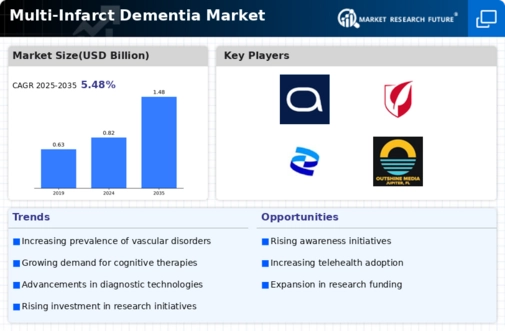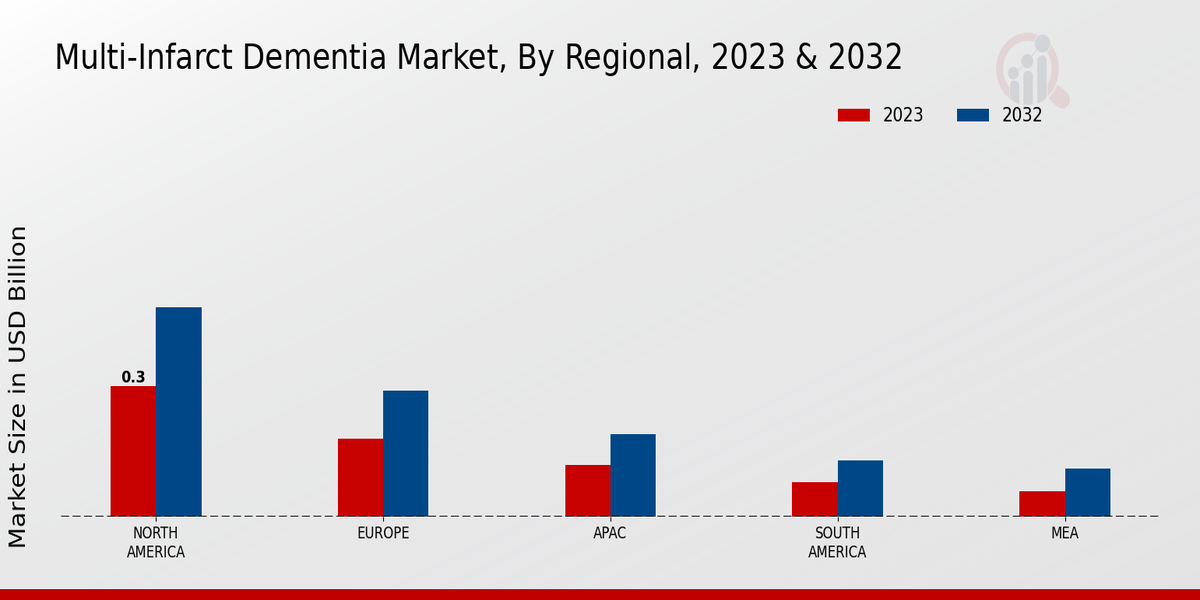Aging Population
The Global Multi-Infarct Dementia Market Industry is significantly influenced by the aging population, as older adults are at a higher risk for developing multi-infarct dementia. With life expectancy increasing globally, the number of individuals aged 65 and older is expected to rise substantially. This demographic shift is projected to contribute to a market value of 1.48 USD Billion by 2035. The implications of this trend are profound, as healthcare providers will need to focus on preventive measures and treatment strategies tailored to the elderly, thereby fostering growth in the market.
Market Growth Projections
Projected growth in the Global Multi-Infarct Dementia Market Industry indicates a promising future. The market is anticipated to reach 0.82 USD Billion in 2024 and is expected to grow to 1.48 USD Billion by 2035, reflecting a compound annual growth rate (CAGR) of 5.49% from 2025 to 2035. These figures underscore the increasing recognition of multi-infarct dementia as a critical public health issue, necessitating ongoing investment in research, treatment, and support services.
Growing Awareness and Education
Growing awareness and education regarding multi-infarct dementia are vital drivers of the Global Multi-Infarct Dementia Market Industry. Increased public knowledge about the symptoms, risk factors, and treatment options is likely to lead to earlier diagnosis and intervention. Campaigns aimed at educating both healthcare providers and the general population can significantly impact the management of this condition. As awareness rises, the demand for healthcare services and support systems will likely increase, further propelling market growth and ensuring that patients receive timely care.
Government Initiatives and Funding
Government initiatives and funding aimed at addressing cognitive disorders are essential for the Global Multi-Infarct Dementia Market Industry. Many countries are implementing policies to enhance research, improve healthcare infrastructure, and promote public health campaigns focused on dementia. Such initiatives can lead to increased funding for research and development of new treatments, thereby fostering innovation in the market. As governments recognize the economic burden of dementia-related conditions, the allocation of resources is expected to rise, supporting the growth of the market.
Advancements in Diagnostic Technologies
Advancements in diagnostic technologies are playing a crucial role in the Global Multi-Infarct Dementia Market Industry. Enhanced imaging techniques and biomarkers are enabling earlier and more accurate diagnosis of multi-infarct dementia, which is essential for effective intervention. As awareness of the disease increases and diagnostic capabilities improve, more patients are likely to be identified and treated. This trend is expected to support a compound annual growth rate (CAGR) of 5.49% from 2025 to 2035, indicating a robust future for the market as healthcare professionals become better equipped to address this condition.
Increasing Prevalence of Vascular Diseases
The Global Multi-Infarct Dementia Market Industry is experiencing growth due to the rising prevalence of vascular diseases, which are significant risk factors for multi-infarct dementia. As vascular conditions such as hypertension and diabetes become more common, the incidence of multi-infarct dementia is likely to increase. In 2024, the market is projected to reach 0.82 USD Billion, reflecting the urgent need for effective management and treatment options. This trend suggests that healthcare systems worldwide must adapt to the growing demand for services related to vascular health and cognitive impairment, thereby driving market expansion.






